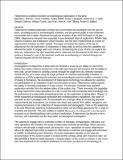| dc.contributor.author | Brennan, Michael L | |
| dc.contributor.author | Cantelas, Frank | |
| dc.contributor.author | Elliott, Kelley | |
| dc.contributor.author | Delgado, James P | |
| dc.contributor.author | Bell, Katherine L C | |
| dc.contributor.author | Coleman, Dwight | |
| dc.contributor.author | Fundis, Allison | |
| dc.contributor.author | Irion, Jack | |
| dc.contributor.author | Van Tilburg, Hans K | |
| dc.contributor.author | Ballard, Robert D | |
| dc.date.accessioned | 2021-09-20T17:30:49Z | |
| dc.date.available | 2021-09-20T17:30:49Z | |
| dc.date.issued | 2018-07-16 | |
| dc.identifier.uri | https://hdl.handle.net/1721.1/131891 | |
| dc.description.abstract | Abstract
Telepresence-enabled exploration of deep sea environments has developed over the past 30 years, providing access to archaeologists, scientists, and the general public to sites otherwise inaccessible due to depth. Pioneered through the inception of the JASON Project in the late 1980 s, telepresence missions have expanded to two dedicated ships of exploration, NOAA Ship Okeanos Explorer and exploration vessel Nautilus, and has been implemented on a series of opportunistic missions on other vessels. This paper chronicles the history of the use of telepresence for the exploration of shipwrecks in deep water as well as how this capability has allowed the public to engage with such missions. Broadening the scope of who can explore the deep sea, telepresence has also expanded what is observed and documented in the deep, which speaks to humanity’s use of the maritime world and an archaeology of discard through our material disposed of into the deep sea. | en_US |
| dc.publisher | Springer US | en_US |
| dc.relation.isversionof | https://doi.org/10.1007/s11457-018-9197-z | en_US |
| dc.rights | Article is made available in accordance with the publisher's policy and may be subject to US copyright law. Please refer to the publisher's site for terms of use. | en_US |
| dc.source | Springer US | en_US |
| dc.title | Telepresence-Enabled Maritime Archaeological Exploration in the Deep | en_US |
| dc.type | Article | en_US |
| dc.contributor.department | Massachusetts Institute of Technology. Center for Computational Science and Engineering | |
| dc.contributor.department | Massachusetts Institute of Technology. Media Laboratory | |
| dc.eprint.version | Author's final manuscript | en_US |
| dc.type.uri | http://purl.org/eprint/type/JournalArticle | en_US |
| eprint.status | http://purl.org/eprint/status/PeerReviewed | en_US |
| dc.date.updated | 2020-09-24T21:40:55Z | |
| dc.language.rfc3066 | en | |
| dc.rights.holder | Springer Science+Business Media, LLC, part of Springer Nature | |
| dspace.embargo.terms | Y | |
| dspace.date.submission | 2020-09-24T21:40:55Z | |
| mit.license | PUBLISHER_POLICY | |
| mit.metadata.status | Authority Work and Publication Information Needed | |
